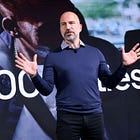Uber Eats is alright, alright, alright
Delivery demand keeps growing and other record highs this quarter. Cool story?
On Sunday, Uber will use its valuable Super Bowl ad time to convince us to order food. Actor Matthew McConaughey stars in an ad for Uber Eats, and a few other celebs — including Martha Stewart and Charli XCX — show up, too.
Eats just posted its biggest quarter-over-quarter increase since the high pandemic days of early 2021. Delivery gross bookings, a metric that includes the total dollar value of orders, including taxes and fees, reached $20 billion in the fourth quarter of 2024. Delivery revenue reached $3.8 billion. For the seventh consecutive quarter, more people are using the service. Ad revenue is up. One million merchants are on the platform, and sales per merchant are increasing.
It’s all so… predictable. Food delivery, which actually managed to eclipse Uber’s ride-hailing business during the worst of Covid, has become Uber’s workhorse, growing steadily but no longer approaching the heights of the company’s ride-hailing business, which posted revenue closer to $7 billion in the fourth quarter.
Has Uber’s delivery business gotten boring?
During the company’s Wednesday morning fourth quarter earnings call, CEO Dara Khosrowshahi fielded just one Eats question from analysts. But according to Khosrowshahi, there’s tons of room for the service to grow. Right now, only a third of existing brick-and-mortar merchants in Uber Eats’ top 10 markets are on the platform. In CEO speak: “There's a huge amount of runway as it relates to selection,” he said.
Khosrowshahi noted one more all-time high last quarter: the number of discounts and promotions, paid for by restaurants and other merchants, promotions, on Uber Eats.
“This is a really important initiative,” he said, “in terms of merchants being able to promote [themselves] on the network and getting boosted in terms of their sort order for that promotion.”
In the fourth quarter, consumers redeemed close to $1 billion worth of offers that were paid for by restaurants and other merchants — not Uber — representing a 60 percent increase year over year.
Related coverage:
^lol did I write the same story a year ago?!
What else?
Olo, a decades-old restaurant digital ordering company, has been clear on its desire to help digitize in-restaurant payments. Per a recent media release, Olo’s new partnership with payments companyFreedomPay (and associated enhanced partnership with Stripe) will help it snag all in-restaurant transactions. Why does this matter? When one third-party facilitates all the payment transactions, regardless of where a customer dines, they know a whole lot more about every customer. — release
I listened to the All In podcast so you don’t have to. While talking with a group of Silicon Valley
“besties”all-male investors, it took Travis Kalanick, CEO of CloudKitchens, less than two minutes to compare his business to Elon Musk’s. (Bits? Atoms?) The Uber founder has long said he wants to do to the kitchen what Uber did to the car — and he repeated this on the show. CloudKitchens has been fine-tuning a bowl-building robot inside some of its facilities, and in April, Kalanick says, five CloudKitchens restaurant customers will launch officially with the company’s bowl-making bots. — All InICE has restaurant workers terrified. Nobody is exactly sure what’s going on, but any threat of deportation is too great to ignore. — Grub Street
Immigrant restaurant workers are not criminals. Per an NBC News report cited in this post, slightly over half (52 percent) of 1,179 people arrested by Immigration and Customers Enforcement in one day last week were considered criminal arrests. The rest “appear to be nonviolent offenders or people who have not committed any criminal offense other than crossing the border illegally.” — The LO Times
Why NYC street vendors are especially vulnerable to ICE raids. “Criminalizing street vending increases the risks of deportation.” — Eater NY
As immigration crackdown looms, restaurants are racked with fear. Restaurants across the country report concern for their futures; many are hesitant to speak out publicly for fear of inadvertently targeting their employees. — New York Times
For like
thirty secondstwo months there was an AI smoothie shop in San Francisco. Better Blends recommended recipes based on generative AI prompts. It shuttered so fast, by the time I rode my bike down Market Street to check it out, the door was locked. That’s because it was a clear and obvious gimmick (and anecdotally I heard the drinks weren’t great.) That’s the vibe I get from any press release touting some sort of AI capability in quick-service restaurants, including a recent announcement from Just Salad, which uses ChatGPT to customize a salad based on a customer’s preferences — as in, “tell me what to eat, robot!” — Fast CompanyAre Instagram olive oils worth it? There’s no mention of Flamingo Estates in this particular olive oil story, but it’s still on trend. (There is a mention of a personal favorite olive oil brand, California-based, woman-owned Fat Gold.) — Consumed







